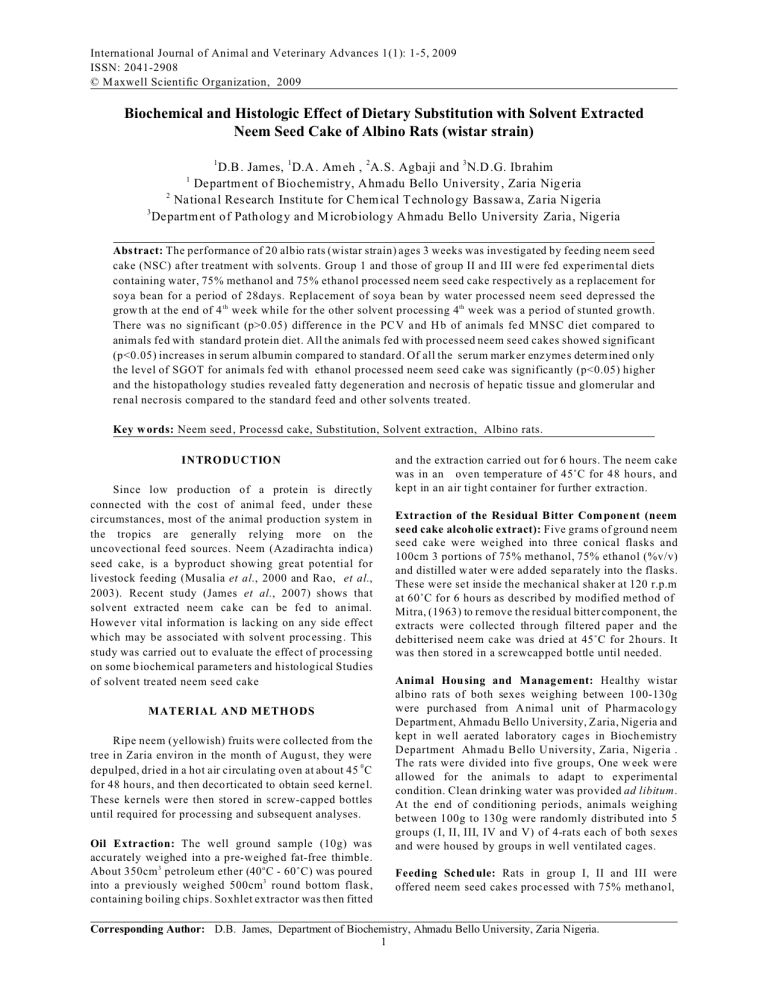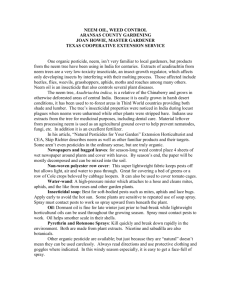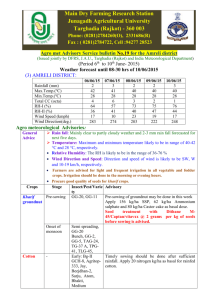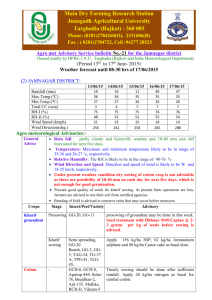International Journal of Animal and Veterinary Advances 1(1): 1-5, 2009
advertisement

International Journal of Animal and Veterinary Advances 1(1): 1-5, 2009 ISSN: 2041-2908 © M axwell Scientific Organization, 2009 Biochemical and Histologic Effect of Dietary Substitution with Solvent Extracted Neem Seed Cake of Albino Rats (wistar strain) 1 D.B . James, 1 D.A . Am eh , 2 A.S. Agbaji and 3 N.D .G. Ibrahim 1 Departm ent of Biochemistry, Ahmadu Bello University , Zaria Nigeria 2 National Research Institute for C hem ical Technolo gy Bassawa, Zaria Nigeria 3 Departm ent of Patholog y and M icrobiolog y A hmadu Bello University Zaria, Nigeria Abstract: The performance of 20 albio rats (wistar strain) ages 3 weeks was investigated by feeding neem seed cake (NSC) after treatment with solvents. Group 1 and those of gro up II an d III were fed expe rimen tal diets containing water, 75% methanol and 75% ethanol processed neem seed cake respectively as a replacement for soya bean for a period of 28days. Replacement of soya bean by water processed neem seed depressed the grow th at the end of 4 th week while for the other solvent processing 4th week was a period of stunted growth. There was no sig nificant (p>0.05) difference in the PC V and H b of an imals fed M NS C diet com pared to animals fed with standard protein diet. All the animals fed with processed neem seed cakes showed significant (p<0.05) increases in serum albumin compared to standard. Of all the serum mark er enzyme s determ ined o nly the level of SGOT for animals fed with ethanol processed neem seed cake was significantly (p<0.05) higher and the histopathology studies revealed fatty degeneration and necrosis of hepatic tissue and glomerular and renal necrosis compared to the standard feed and other solvents treated. Key w ords: Neem seed , Processd cake, Substitution, Solvent extraction, Albino rats. INTRODUCTION Since low production of a protein is directly connected with the cost of anim al feed, unde r these circumstances, most of the animal production system in the tropics are generally relying more on the uncovectional feed sources. Neem (Azadirachta indica) seed cake, is a byproduct showing great potential for livestock feeding (Musalia et al., 2000 and Rao, et al., 2003). Recent study (James et al., 2007) shows that solvent extracted nee m cake can be fed to animal. However vital information is lacking on any side effect which may be associated with solve nt proc essing . This study was carried out to evaluate the effect of processing on some b iochem ical parameters and histological Studies of solvent treated neem seed cake MATERIAL AND METHODS Ripe neem (yellowish) fruits were collected from the tree in Zaria environ in the month o f Augu st, they were depulped, dried in a hot air circulating oven at about 45 0 C for 48 hours, and then deco rticated to obtain seed kerne l. These kernels were then stored in screw-capped bottles until required for processing and subsequent analyses. Oil Extraction: The well ground sample (10g) was accu rately weighed into a pre-weighe d fat-free thimble. About 350cm 3 petroleum ether (40 o C - 60/C) was poured into a previously weighed 500cm3 round bottom flask, containing boiling chips. Soxhlet extractor was then fitted and the extraction carried out for 6 hours. The neem cake was in an oven temperature of 45/C for 48 hours, and kept in an air tight container for further extraction. Extraction of the Re sidual Bitter Com ponent (neem seed cake alcoh olic extract): Five grams of ground neem seed cake were weighed into three conical flasks and 100cm 3 portions of 75% methanol, 75% ethanol (%v/v) and distilled w ater w ere added separately into the flasks. These were set inside the mechanical shaker at 120 r.p.m at 60/C for 6 hours as described by modified method of Mitra, (1963) to remove the residual bitter component, the extracts were collected through filtered paper and the debitterised neem cake was dried at 45/C for 2hours. It was then stored in a screwcapped bottle until needed. Animal Hou sing and Management: Healthy wistar albino rats of both sexes weighing between 100-130g were purch ased from A nimal unit of Pharm acolo gy Department, Ahmadu Bello University, Z aria, Nigeria and kept in we ll aerated laboratory cages in Biochemistry Department Ahmad u Bello U niversity, Zaria, Nigeria . The rats were divided into five groups, One w eek w ere allowed for the animals to adapt to experimental condition. Clean drinking water was provided ad libitum. At the end of conditioning periods, animals weighing between 100g to 130g were randomly distributed into 5 groups (I, II, III, IV and V) of 4-rats each of both sexes and were housed by groups in well ventilated cages. Feeding Sched ule: Rats in grou p I, II and III were offered neem seed cakes processed with 7 5% methanol, Corresponding Author: D.B. James, Department of Biochemistry, Ahmadu Bello University, Zaria Nigeria. 1 Int. J. Anim. Veter. Adv., 1(1): 1-5, 2009 Table 1: Die tary componen t (w/w) of the diet containing processed neem seed cake. Ingredient WNSC 1 MNSC 2 ENSC 3 SFD 4 CFD 5 Yellow m aize 1 46.62 51.10 52.19 44.41 Soya bean m eal 32.38 Processed Neem cake 30.18 25.69 24.60 Corn Pom ace 10 10 10 10 Limestone 0.50 0.50 0.50 0.50 Salt 0.50 0.50 0.50 0.50 Vitam in Pre mix 1 0.20 0.20 0.20 0.20 Cor n O il 10 10 10 10 Bone M eal 2.00 2.00 2.00 2.00 TOTAL 100 100 100 100 Cru de P rotein 2 19.65 19.93 19.75 19.50 15.00 Crude Fibre 2 6.62 4.22 6.60 5.02 7.00 W N S C = W ater pro cessed neem seed c ake; M N S C = Methanol processed neem seed cake; ENSC = Ethanol processed neem seed cake; R F D = Reference diet conta ining soy a be an m eal; C FD = C om me rcial f eed diet. 1 The vitam in-prem ix used in this study is a product of Pfizer Nig.Ltd. Each contains Vit.A (I.U), 10,000; Vit.D ; 2 Determined , ( I.U); 2,000;Vit..E(I.U); 2.5;Vit.K (mg); 20 Choline (mg),300; Riboflavin (mg),4.2; Folic a cid (m g), 0.5; M ethion ine (m g), 0.22 5; M n (mg), 56.0; I (mg), 1.0; Fe ( mg) , 20.0; Cu ( mg),10.0; Zn (mg), 1.25; and C o (mg ), 1,25. Table 2: Effect of processed neem seed cake on change in weight of rats. Diet Average Intial Weight Average Final Weight W ei g h t C h a n g e (% bod y w eight) W N SC 70.63 65.23 - 4.90c M N SC 75.25 94.00 18.75 b E N SC 76.63 97.25 20.62b SFD 80.00 101.81 21.81 b CFD 96.69 129.22 32.53 a Pooled -(S EM ) 2.21 WN SC=W ater processed neem seed cake MN SC=M ethanol processed neem seed cake SFD =Standard protein feed diet; SEM=Standard error of the means CFD =Com mercial feed diet; Values are means of four determinations. M eans w ith different superscript in a row differ significantly (p<0.5). 75% ethanol and water, group IV w ere given diet containing soya meal as a protein source, group V was fed commercial diet (Pfizer Nigeria Limited). The different proportions of the feed ingredients are shown in Table 1. At the end o f 28-days of feeding trials, the a nimals were anaethesied by using chloroform, and were bled by cardiac puncture, the blood were collected in specimen bottles and a lateral section was cut through each. Liver, kidney and spleen were excised. Tissue sam ples were fixed in 10% formalin and histopathological studies was carried out by the method of (Igbo kwe, 198 9). Part of the whole blood was used for PCV and Hb (Dacie, and Lew is, 1991) parameters. The remaining blood was allowed to cloth and serum separated using pasture pipette into clean and labeled sample bottles for determination of some biochemical parameters. Serum transaminase (ALT and AST) was determine by method of Reitman-Frankel, 1957, serum protein by Plumer, 1978 and serum album in (Douma s et al., 1971). Fig 1: Body Weights Change (G) Of Rats Fed Diets Containing Processed Neem Seed Cake Statistical Analysis: The data were subjected to two-way analy sis of variance and differences between the means of diets were tested (Snedec or and C ochran, 19 80). RESULTS AND DISCUSSION The effect of processed neem cake on live weight are shown in Tab le 2 and Figure 1. The body weight of rats fed with water- processed neem seed cake decreased significa ntly (p< 0.05) compared to other processed diet and the stan dard. Biochemical parameters (Table 3 and Figure 2) show no significant (p>0.05) differences in the levels of serum marker enzymes (SGPT and SGOT) in animals fed water and methanol processed neem cake and that of standard protein diet. However, the level of SGOT in rats fed with ethanol processed neem cake significantly (p<0.05) increased com pared to the standa rd protein diet. hematological parameter ( Table3) indicate no significant difference between the PCV and Hb on methanol processed neem seed cake (MNSC ) compared to the Fig 2: Change in PCV Level of Rats Fed With Processed Neem Seed Cake standard protein diet, however significant reduction in PCV and Hb w as observed in animals fed with ethanol processed neem seed cak e (ENSC). There was no significant (p>0.05) difference in the level of serum protein (Table 3) in all processed neem seed cake compared with standard protein diet and commercial diet. The serum albumin in standard pro tein diet and com mercial are significantly (p<0.05) lower than all neem processed products. 2 Int. J. Anim. Veter. Adv., 1(1): 1-5, 2009 Table 3: Diet WNS C Effect of processed neem seed cake on some heam atological and biochemical parameters. PCV Hb (g /100m l) Seru m A lbum in (g/10 0m l) Seru m P rotein (g /100m l) SG PT U/L SG OT U/L 40a b a a a 13 4.38 6.78 38.00 21.00 b MN S C 41 a a a a a 14 4.40 6.60 37.50 23.50 b E NS C 39 b b a a a 13 4.05 6.73 40.25 32.00 a SFD 41 a a b a a 14 3.80 6.89 38.50 19.00 bc CFD 39 b 6.77 a 13 b 3.87 b 42.50 a 15.00 c Pooled Sem 0.49 0.18 0.10 0.13 0.91 1.26 WN SC=W ater proces se d n ee m se ed ca ke ; E N S C =E th an o l p ro ce ss ed n ee m se ed ca ke ; M N S C = M et ha no l p ro ce ss ed n ee m se ed ca ke ; S F D =S ta nd ar d p ro te in fe ed ; C F D = Com mercial feed diet SEM=S tandard error of the mean. Values are means of triplicate determinants. Means w ith different s upers cripts in c olum n differ significa ntly (p<0.05). The histopathological studies showed no cellular infiltration or observab le tissue damage in the animals fed water processed and methanolic processed neem cake (Plate I, II, III,V,VII and VIII). However, those fed on ethanol processed neem cake (Plate IV and VII) showed fatty dege neration and necro sis of the hepa tic cells as well as glomeru lar and renal tubular n ecrosis in the kidney . Average grow th rate of the rats indicated a general decrease at the second week of the experiment for processed neem seed cak e, while at the third week , there was a general increase. The fourth week was a period of stunted growth, and a decrease in weight of animal fed water processed neem seed cake. This could be as a result of reduc tion of feed co nversion w ith increase in the age of the animals (Omo le and O nwu dike, 1981 ). Biochemical indices show sub-molecular effect of nutrients. Data on hema tological indicate no significant difference between the PCV and Hb of animals fed MN SC com pared to the standard protein diet w hile there was significant (p<0.05) decrease in animals fed on ENSC, this shows that animals that feeds on ENSC might develop anaemia. Anaemia is a reduction in the number of erythrocytes, haemoglobin, or both in the circulating blood. It results from ex cessiv e red blood c ell (RBC) destruction, RBC loss, or decreased RBC production and is a manifestation of an underlying disease process; therefore, the respon se to treatment of anaemia is transient unless the und erlying disease proc ess is addressed (Straus, 1998). There was no difference between the standard and the neem processed seed cakes results for serum protein, however all the processed neem seed cake showed significant (p<0.05) higher serum albumin level compared to the stan dard protein diet. Inclusion of processed neem seed cake especially MN SC have no reducing effect on the mobilization of nutrients from the diets, hence there is no reduction effect on serum levels of biomo lecules,. In fact processed neem seed cake in this study has been found to significantly (p<0.05) increase the level of serum album in com pared to stand ard diet. Low serum album in has also been assoc iated w ith low protein intake. Animals that grow at a faster rate than others sometimes have higher serum albumin, Hb, glucose and low concentration of potassium (Mitchell and Macleod, 198 3; M cDonald et al., 1994). The processed neem seed cake in this study can be said to be of good protein content, however it has been show n that feeding trial of 10, 15 and 20% neem seed cake included in concentrate mixtures to lactating buffaloes shows lower RBC, WB C, and haemoglobin Plate I: Photomicrograph of a section of liver from a control rat fed with standard feed Note: The normal microscopic appearance of the liver section. H & E. X 400 Plate II: Photomicrograph of a section of liver from a rat fed with water processed neem seed cake Note: The normal microscopic appearance of the liver section . H & E. X 400 levels (Pyne et al., 1979). The difference may be as result of processing done in this study. The level of serum marker enzymes (SGPT and SGOT) of the animal fed water and methanol processed neem seed cak e compared w ell with standard protein diet, however the level of SGOT for ethanol processed neem seed cake significantly (p< 0.05) increased comp ared to the standard. B oth SGPT and SGOT are excellent marker of liver damage caused by exposure to toxic substances (Ranjna, 1999), SG OT is not specific for the liver o nly but is also located in other organs like the heart, brain, kidney and skeletal muscle. SG PT is mo re liver specific 3 Int. J. Anim. Veter. Adv., 1(1): 1-5, 2009 Plate III: Photomicrograph of a section of liver from a rat fed with methanol processed neem seed cake. Note: The normal microscopic appearance of the liver section.H & E. x 400 Plate VI: Photomicrograph of a section of kidney from a rat fed water processed neem seed cake. Note: The normal microscopic appearance of the kidney section. H & E stain x 400 Plate IV: Photomicrograph of a section of liver from a rat feed ethanol neem seed cake (ENSC). Note: Fatty degeneration (F) and necrosis (N) of the hepatic cells. H & E. x 400 Plate VII: Photomicrograph of a section of kidney from a rat Fed with methanol processed neem seed cake.Note: The normal microscopic appearance of the kidney section. H & E stain x 400 Plate V: Photomicrograph of a section of kidney from a control rat fed with standard feed. Note: The normal microscopic appearance of the kidney section. H & E stain x 400 Plate VIII: Photomicrograph of a section of kidney from a rat fed with ethanol neem seed cake (ENSC). Note: The glomerular (G) and renal tubular necrosis (TN). H & E stains x 40 enzyme for diagnostic use when the integrity of the hepatocellular membrane is co mpromise, there is extrusion of the enzyme into the plasma (Moss and Henderson, 1999 ). Elevation in the activity of SGOT in ethanol processed neem cake can be asso ciated with cell necro sis of many tissues. Pathology involving the skeletal or cardiac muscle and/or the hepatic parenchyma, allows leakage of large amounts of this enzyme. 4 Int. J. Anim. Veter. Adv., 1(1): 1-5, 2009 The histopathological studies showed no cellular infiltration or observable tissue damage for the animal fed with water, and methanol processed neem seed cake. Those on ethanol processed, showed fatty degeneration and necrosis of the hepatic cells, as well as glomerular and tubular necrosis in the kidney thus suggest that the inclusion of ethanol processed neem seed cake on the diet of rats is not safe. Similar findings (Subbarayuda and Reddy, 1975) have reported fatty changes in liver, and sluggish spermatogenesis in Bobcock cockerels fed deoiled neem seed cake. Mitra, C.R., 1963. India Central Oil Seed Committee. Hyderabad. I edn. Examiner Press, Bomba y, India pp. 19 0. Mo ss, D.W . and A .R. H enderson , 1996 . Enzymes In: Tietz fundamental of clinica l chem isty 4th edn, T ietz NW (ed) W .B So unders compa ny philadalphia pp: 283-335 Musalia, L.M., S. Anandan, V.R.B. Sastry and D.K. Agrawal, 2000. Urea-treated neem (Azadirachta indica) Seed kernel cake as a protein supplement for lambs. Small Ruminant. Res. 35: 107-116 Omole, T.A. and O .C. O nwudike , 1981 . Investigation of the treatme nt of sawdust for rab bit feeding 2: Effect of boiling and incubation with poultry manure. Anim. Feed Sci. Tech., 6: 51-61 Plumer, T.D., 1978. An Introduction to Practical Biochemistry 2 n d ed.U.K. McGraw Hill book Co. pp: 144-146 Pyne, A.K ., D.N . Moitra and P. Gangopadhyay, 1979. Studies on the composition of milk with the use of neem seed expeller cake in lactating buffaloes. India Vet. J., 56: 223-227 Ranjna, C., 1999. Practical Clinical Bioc hemistry Methods and Interpretation. 2nd edn, pp:117 Rao V.K ., B.N. Kowale and A.K. Verma, 2003. Effect of feeding water washed neem (Azadirachta indica) seed kerne l cake in the quality, lipid profile and fatty acid composition of goat meat. Small Rum inant R es., 47:213-219 Reitman S., S. Frankel, 1957. Colorimetic method for the determination of serum transaminases. Am. J. Clin. Pathol., 28: 56-63 Snereco r, G.W. and W .G. Cockhran, 1980. Stastistical methods, 6 th edn. Oxford and IBH Publishing Company, New D elhi, pp: 258-298. Straus, J.H., 1998. Anaemia. In: Merck Veterinary Manu al: A handbook of diagnosis, and therapy for Veterinarians. 8th ed. Merck and Co. Inc. W hitehouse Station, N. J. U.S.A. pp: 8-18 Subbanayudu D., and R. Reddy, 1975. Utilisation of Deoiled Neem Seed Cake in Chick Rations. 4 th. Poultry. Sci. Sym., pp:38 (Bhubaneswa r, Orissa www .tropentag.de/2005/abstracts/full/312.pdf CO NC LU SION Data on hematological and biochemical parameters indicate that the PCV , Hb and serum protein of anim als on MN SC processed neem seed cake showed no significant (p<0.05) change compared with standard diet and the histopathological studies of the organs showed no cellular damaged hence it safe w hen incorporated in to animal feed. REFRENCES Dacie, J.V. and S.M. Lewis, 1991. Practical haem atologyn7th (Ed.) E LB S with Ch urchill Livingstone, England, pp: 37-85 Doum as, B.T; W atson, W .A an d H.G. B riggs, 1971. Albumin standard and measurement of serum album in with bromocresol green (BCG). Clinical Chemical Acta, 31: 87-90 Igbokwe, I.O., 1989. Post-mortem examination of carcasses, Zaria Veterinarian 4: 145-152 James, D.B., D.A. Ameh, and A.S. Agbaji, 2007. Effect of solvent extraction o n crude protein, in-vitro protein digestibility and amino acid profile of neem see cake. Asian J. of Anim. and V eter. Adv., 2(2): 81-85 Mcdonald, P., R.A. Edward, J.F.D. Greenhalgh and C. Morgan, 1995. Anim. N utr., Longman Publisher. pp. 221-297. www.netstoreusa.com/mnbooks/058/0582 219272 .shtml Mitchell, M.A., and M.G. Macleod, 1983. Some bioch emical Effec ts associated with changes in heat production and food intake in the domestic fowl during adaptation to high environmen tal temperature (32/C). IRCS Med. Sci., 20: 96-103 5





